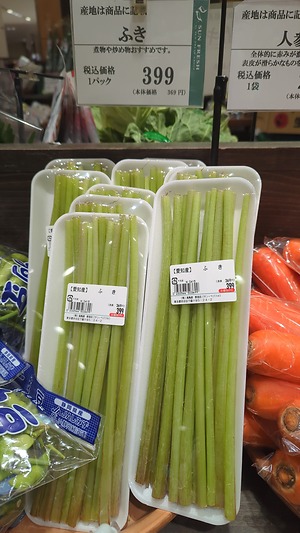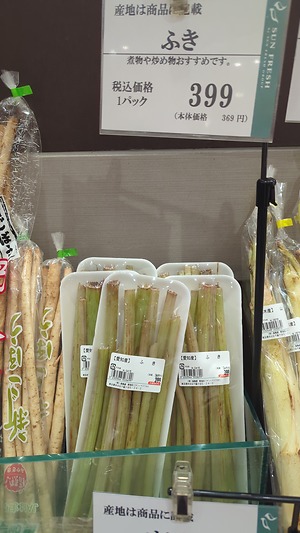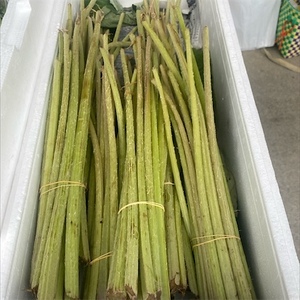


Fuki
Estimated Inventory, lb : 0
Description/Taste
Fuki widely varies in length, depending on how it is prepared to be sold in local markets. In the wild, the stems can grow from 0.9 to 1.2 meters in height, but most of these stems are trimmed to smaller sizes for ease of purchase in markets. Fuki is generally sold when the stems are 1 to 2 centimeters thick and 50 to 55 centimeters in length. The stems are straight, cylindrical, and thick, and in some markets, they are sold with their large single leaf still attached with an elongated, cordate to tapered shape. The stems also have a semi-rough, firm, and textured feel and showcase prominent strings of fiber that extend the length of the stem. Fuki ranges in color from pale green to dusty green, and the stems are occasionally covered in tiny hairs. When broken open, the stems are fibrous, fleshy, and moist, and some stems may be hollow. Fuki should remain upright and firm when selected in markets. If the stems are sagging, it is a sign that they aren't as fresh. The ends should also be green and not brown and dry. Fresh Fuki has a grassy, earthy, and green scent, and when cooked, the stems are initially sour, vegetal, and bitter with a grassy, earthy, and subtly sweet flavor.
Seasons/Availability
Wild Fuki is available in the spring through early summer. Cultivated Fuki has an extended season, generally found in markets from the early winter through mid-summer.
Current Facts
Fuki, botanically classified as Petasites japonicus, is an herbaceous perennial species belonging to the Asteraceae family. The name Fuki is a Japanese descriptor for the stems of a plant commonly known as Butterbur, Giant Butterbur, Japanese Butterbur, and Sweet Coltsfoot. There are many different types of Fuki, including wild and cultivated varieties, found throughout East Asia, but Fuki is a term primarily used to describe the types native to Japan. Aichi Wase Fuki is considered the most prominent variety in Japanese markets, accounting for around 70% of the commercially grown Fuki. Historically, Fuki was a seasonal and regional item gathered in the spring and early summer in Japan for culinary and medicinal uses. The long and delicate stems were hand harvested and sorted into bundles, and consumers would incorporate the fleshy stems into various cooked preparations. Over time, Fuki expanded in popularity and was commercially produced to extend its season. In the modern day, Fuki is favored for its subtly bitter, green flavor but has become more of a traditional crop fading from mainstream use. Beyond the stems, the species is also known for its immature springtime flower buds known as Fukinoto. These small buds are revered for their limited availability and are another ingredient used in traditional recipes in Japan.
Nutritional Value
Fuki is a source of fiber to regulate the digestive tract, potassium to balance fluid levels within the body, and calcium to build strong bones and teeth. The stems may also provide low amounts of vitamin C to boost the immune system, zinc to heal damaged tissues, and other nutrients, including manganese, B vitamins, and beta-carotene. In Japan, Fuki was once used in natural medicines for its anti-inflammatory and antioxidant properties. The stems and leaves were thought to help reduce phlegm and coughs and were also consumed to detox the body to prevent food poisoning. It is important to note that Fuki should be eaten in small quantities as the plants may contain pyrrolizidine alkaloids, organic compounds that may be harmful in large doses. Many of these alkaloids are removed during the boiling and cooking process, but care should be taken to determine individual health needs.
Applications
Fuki has a vegetal and subtly bitter taste suited for cooked preparations. The stems must be washed, boiled, and peeled before use to remove astringency and reduce bitterness. Fuki is traditionally cut into smaller pieces and is cooked with salt for 3 to 5 min, depending on the stem thickness. Once cooled, the stems are peeled to remove their fibrous outer layer, and the interior of the stem can be tossed into salads, cooked in stir-fries, or simmered in soups. Try combining Fuki with miso and spreading the mixture over a bowl of hot rice as a savory meal or frying the pieces into a crisp and chewy tempura. Fuki can also be wrapped in fried tofu or pork or marinated in sauces with soy, sake, or mirin for added flavor. One of the most popular dishes utilizing Fuki is tsukudani, a Japanese recipe that cooks the stems in a sweet and sour marinade. The stems can also be pickled as a tangy condiment. Fuki should be stored in a sealed container to prevent moisture loss and kept in the refrigerator. It is recommended to immediately prepare and consume the stems after purchase for the best quality and flavor. Fuki can also be boiled and frozen for up to one month.
Ethnic/Cultural Info
On the island of Hokkaido, the Ainu people believed Fuki was a shelter for the Koropokkuru, which were tiny human-like creatures. The Koropokkuru are also referred to as Koro Pokunguru, Kor-pok-un-kur, and Koro-pok-guru, and their name roughly translates to "the people beneath the Fuki." These mythological creatures varied in description as they were as whimsical as the stories that portrayed them, but in general, the Ainu people referred to these creatures as having large heads, being somewhat hairy, and emitting a distinct odor. Despite their peculiar appearance, the Koropokkuru excelled in pottery and were able to communicate with the Ainu. Overall, these creatures were primarily shy and hid beneath the large Fuki leaves to provide shelter and protection from weather and encounters with humans. Stories of the Koropokkuru are still shared with children in the northern regions of Japan in the present day, and the mythical creatures are closely associated with the traditions of growing and harvesting Fuki.
Geography/History
Fuki is native to Japan and has been growing wild since ancient times. The species has also been found wild in China and Korea. In Japan, the stems and sprouts have been commercially cultivated since the Heian period, spanning from 794 to 1185 CE. Fuki thrives in the moist soils of the mountainous regions of Hokkaido, Honshu, Shikoku, and Kyushu. The species is commonly found alongside streams, rivers, embankments, irrigation canals, roadsides, ditches, and low-elevation woodlands. In addition to wild Fuki, the plants are also grown in greenhouses in the Gunma, Fukushima, and Hokkaido Prefectures for commercial sale. Commercially grown Fuki is available for a longer season than foraged Fuki, and growers can almost cultivate the species year-round for increased use in culinary preparations. Today Fuki can be gathered from the wild, cultivated in greenhouses, or grown in home gardens and sold fresh through local markets and grocers. Outside of Asia, the sprouts can sometimes be found growing in home gardens in North America and Europe, as Japanese immigrants once introduced the species. The Fuki featured in the photograph above was sourced from Tokyo, Japan.










